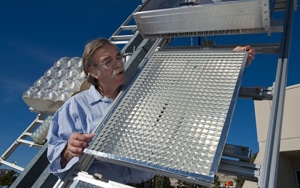
Seed money from DOE, together with the experts at the NREL-based SunShot Incubator Program, lifted Semprius from a small electronics start-up with a novel idea to a real difference-maker in the solar cell world.
Semprius’ triple-junction cells are made of gallium arsenide. Low-cost lenses concentrate the sun light onto the tiny cells 1,100 times. Their tiny size means they occupy only one-one thousandth of the entire solar module area, reducing the module cost. In addition, the use of a large number of small cells helps to distribute unwanted heat over the cell’s structure.
Semprius engineers use the company’s patented micro-transfer printing process to allow the micro-cells to be transferred from the growth substrate to a wafer. In a massive parallel process, thousands of cells are transferred simultaneously.
This low-cost approach, which Semprius executives say can cut manufacturing expense by 50 percent, caught the eye of energy giant Siemens, which this year took a 16 percent stake in Semprius, as part of a $20 million investment from venture capitalists.






